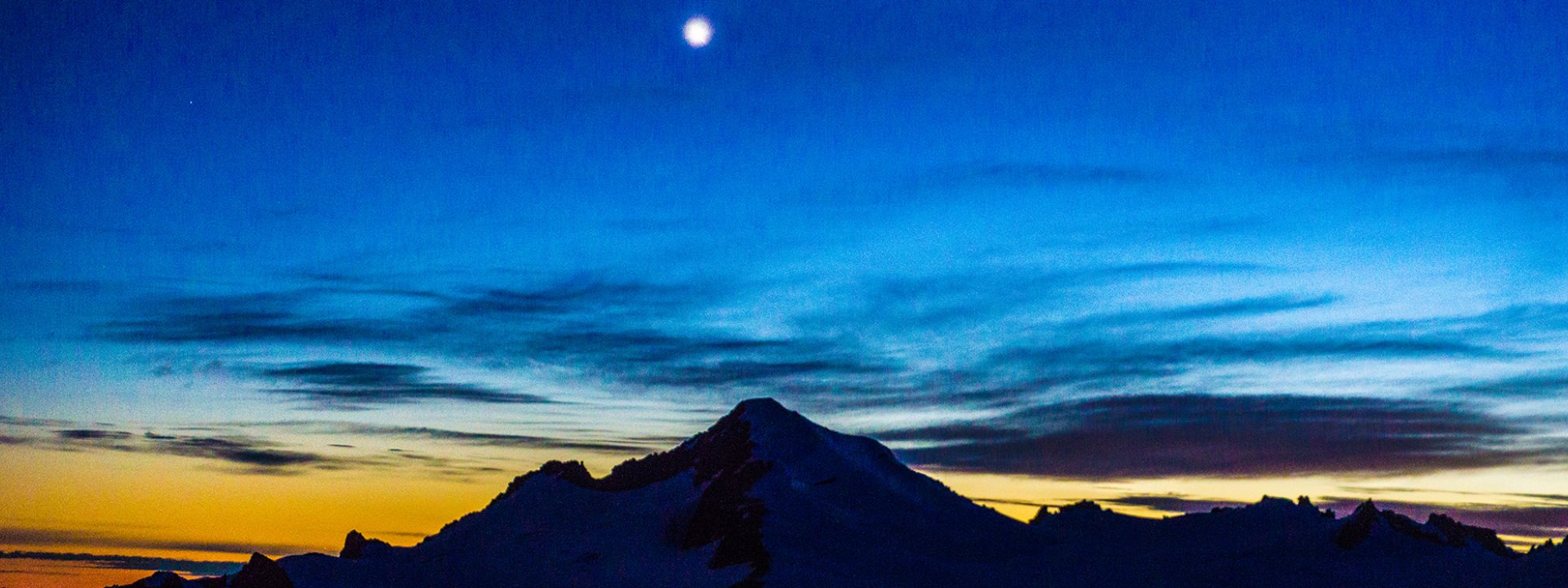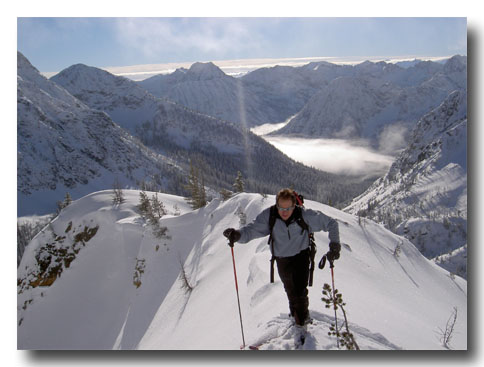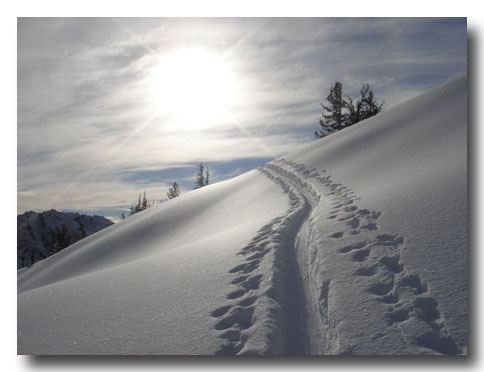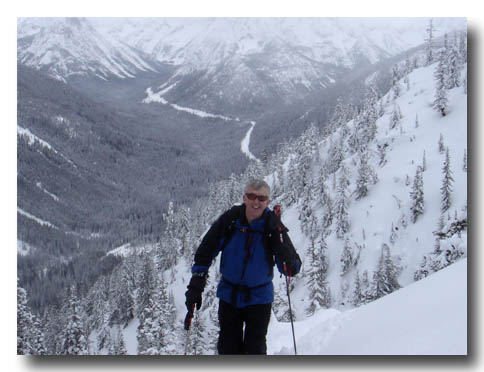Compiled by Scott Johnston
Scott on the Uptrack
Over the years we have had the opportunity to experience the good, the bad and the ugly when it comes to ski touring conditions. Little tips can go a long way toward making the whole experience much easier and more enjoyable. Here are some simple ideas gleaned from years of touring that you may find useful for some of your outings.
- Blisters are a common problem, especially on warm spring tours. All the mole skin in the world can’t help you out in certain circumstances. Here is a little known secret of mine that has worked almost every time we have used or recommended it. Buy some cheap knee high stockings and wear them under your normal socks. They dramatically reduce blisters and can even eliminate the dreaded shin bang of stiff boots (don’t worry you’ll know what this is when you get it). They weigh nothing and take up almost no pack space, so take a few pair along on multiday tours. You will feel so smug and helpful when you lay them on some hapless tourmate.
- The fancy skin glop that is sold to combat skin icing works well, but even easier to carry and apply is a small block of soft (ie. yellow) alpine ski wax. Rub this block on your skins and they’ll make your skins glide better and keep them from picking up snow when the skins become wet and you chance into cold powder. The alpine wax can also be used on your ski bases when your bases are dry.
Following the Contours
- When skinning uphill try to follow the natural contours of the terrain, making long sweeping curves. The aesthetic appeal of this is obvious but more importantly is the time and energy savings. Using the contours and taking a more gradual uptrack will actually save you a bunch of energy over the steep line, which, at first glance, looks more direct. Here’s why; the steep track will require you to shift into a lower gear, especially when breaking trail in deep snow. This then causes everyone behind to slow way down as well. You can only go as fast as the trailbreaker. On steep tracks, the folks following have almost as hard a time as the first person. This higher energy cost will catch up with the group on a big day out. If you are planning to lap the slope, then a gradual track will mean that on subsequent climbs your skins will continue to grip well, thereby assuring an easy climb as the track becomes slicker with multiple uses. Steep uptracks often necessitate the use of kick turns. These should be avoided if at all possible. When each skier in line makes a kick turn, all the skiers behind must stop and wait till that person’s turn is complete and they have moved out of the corner. So, the whole line of skiers can only move at the slowest speed through the corners. With rounded corners no one has to slow down and the whole group can ascend at the same speed. At a moderate all day touring pace, all but the strongest skiers will find that they gain elevation faster on a lower grade uptrack than a steeper one.
A windy transiton
- Stop below the top of ridges to switch into downhill mode. Avoid standing on ridge crests if at all possible. You’ll undoubtedly be a bit sweaty from the climb and you can chill off really fast on a breezy ridge. Hunker down in a sheltered place; have quick drink while de-skinning and save the longer lunch stop for the bottom of the run when you are likely to be out of the wind. You have the added benefit of being able to admire your turns while eating lunch and enjoying the camaraderie of your tour partners.
- Carry a thermos with your favorite hot drink. Small lightweight thermoses can turn a cold windy stop to skin up or de-skin into a pleasant break. Water needs to be in some sort of insulated container. We have found bladders with hoses almost always freeze in winter so a foolproof system is a must if you choose to use one. Hydration is crucial for long tours; Hydrate or Die!
Choking Up on the Uphill Pole
- Don’t wear your ski pole straps. On the climbs you’ll constantly be side hilling to some degree. You’ll need to choke up on the uphill pole. If at each change of side hill you have to take the pole strap on and off, you’ll slow your pace and everyone behind you. In trees, especially thick stands, skiing with pole straps is asking for a shoulder or elbow injury should you ever hook a basket in a tree. At the very least, it can make you come to a very sudden and ungraceful stop. In an avalanche, poles can inhibit your ability to swim and stay close to the top of the moving snow.
- A small repair kit is worth its weight in gold when a backcountry repair is necessary. The following are the most commonly used items in our repair kits:
- Leatherman with the Philips Head ground down to a posi-drive. You can also use a dedicated ‘binding buddy” but a leatherman works for everything including cutting your block of cheese.
- Home- made Pole splint – all you need is an old ski pole, hose clamps, hack saw and some sand paper. Cut out a 5” to 6” section of the pole. Cut that section in half lengthwise. Round the sharp corners and you are ready to go.
- Duct Tape – self explanatory
- Small Headlamp – days are short and it’s hard to turn around early when the skiing is good
- Rubberized ski strap – similar to duct tape in its ability to fix a wide range of problems
- Extra batteries – for your headlamp and beacon (make sure both items use the same batteries)
- Knotted Accessory Cord – 3 to 4 millimeter, 7-8 meters. Used for cutting cornices and rutsch blocks.
- Save the Gore tex for the chairlift. Touring uphill generates a lot of heat and you’ll create your own private sauna on the uphills. There isn’t a laminated H2O proof fabric made that breathes well enough for uphill touring. Besides these garments are usually much bulkier and heavier than their soft shell counterparts, and take a lot of room in what ideally should be as small a pack as possible. NCMG studies have shown hard shell jackets breathe best when they are in your pack! With the water repellency of modern soft shells, these are the ideal winter ski touring jackets and pants.
Category







